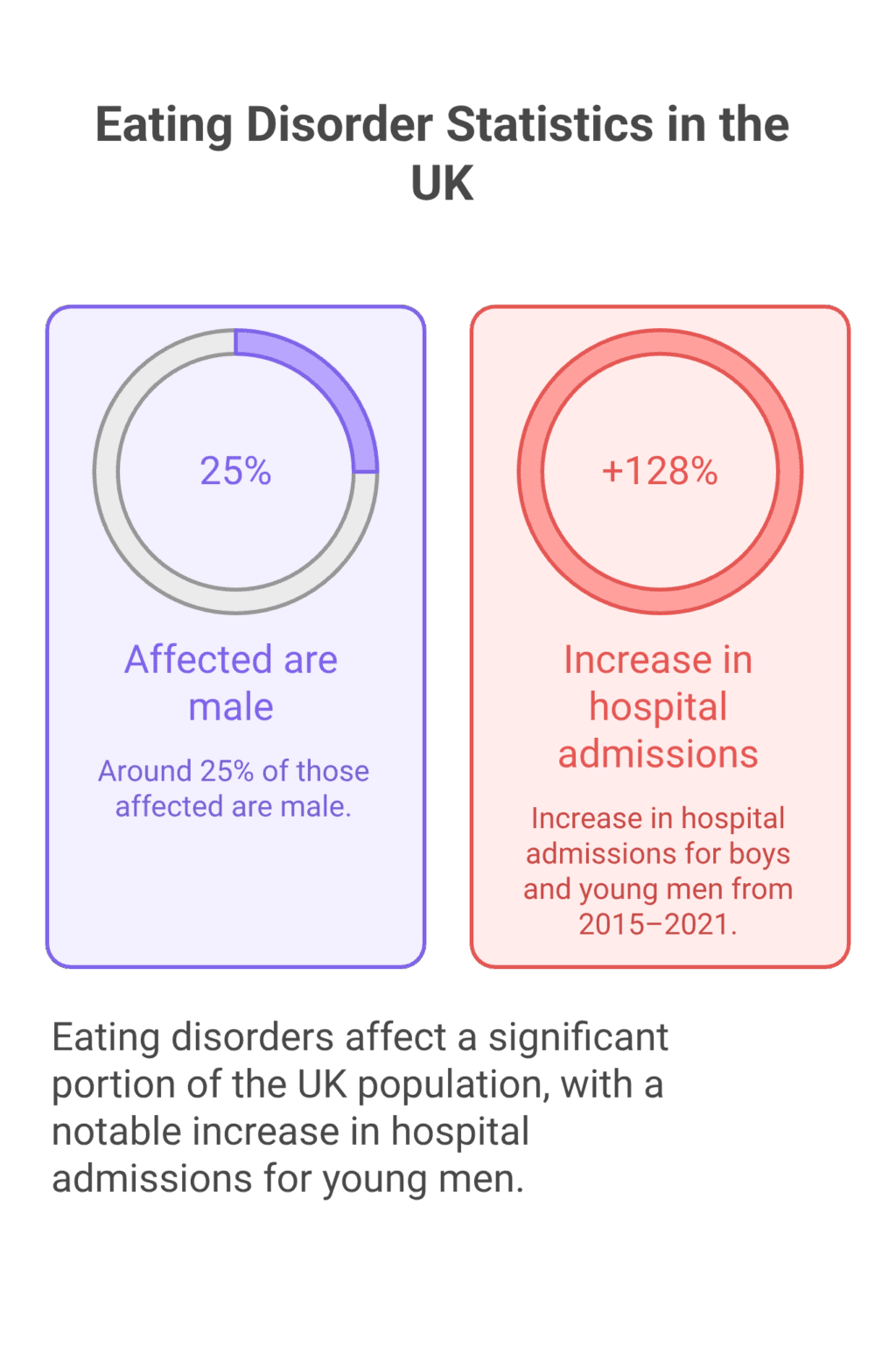When comedian Dave Chawner got in touch about his new show, we were delighted to help spread the word — and to share his important message about eating disorders and mental health.
Dave is an award-winning stand-up, author, and campaigner who uses comedy to talk honestly about subjects many people shy away from. His critically acclaimed shows, including Normally Abnormal and Undermind, draw on his own experience of living with anorexia to challenge stereotypes and spark open, hopeful conversations about recovery.
In this piece, Dave offers a candid look at what anorexia really looks like — and why humour, honesty, and empathy can help break down the stigma around men’s mental health.
In 2014 I wrote a stand up show about anorexia. I thought I was ready to talk about it openly. However, I was wrong. It’s one thing to tell a friend or family member that you’ve had an eating disorder, but very different to tell the general public. But I wanted to as it’s a huge problem – it’s affected people like Kelly Clarkson, Lily Allen, Victoria Beckham. It’s a huge problem – it’s responsible for a lot of God-awful music.
What people get wrong about anorexia
Don’t get me wrong, most people were lovely, supportive and encouraging. The feedback, comments and stories were overwhelmingly lovely. However, as soon as I’d disclosed my history of anorexia, some people’s gaze would shift downwards, their eyes would narrow and they’d tentatively ask, ‘but you don’t look anorexic?’
My aim here, isn’t to vilify those people or decide what people can and can’t say. Don’t worry, I’m not part of ‘The Language Police’ stepping down from my self-righteous pedestal to tell you what you can and can’t say. My objective is to question, what does an anorexic look like?
If the red-top media is to be believed, it’s an emaciated white middle class teenager sitting on a tiled floor hugging her knees with her head bowed in between her legs. However, as with so many things in life, the tabloid truth and the actual truth are miles apart.
You might think all anorexics are ‘skinny’. However, eating disorders are a mental problem not a physical one.
The villains in old movies were always the ones who looked “sick” or “broken.” Turns out that’s complete bollocks. But people still think if you look okay on the outside, there’s nothing wrong on the inside.
You can’t judge someone’s mental health from their physical appearance. Eating disorders are actually about the mental impact rather than the physical look. Numbers don’t tell the full story – BMI, weight and waistlines can be an indicator, not an explanation.
Let me give an example. You don’t have to drink a certain amount of units of alcohol a day in order to ‘qualify’ as an alcoholic. It’s the same with eating disorders; the line between ‘healthy’ and ‘unhealthy’ can be tricky to define. One thing is certain, that line definitely can’t be measured using bathroom scales.
Men get eating disorders too
Perhaps they meant I didn’t look anorexic because I was male. Typically, eating disorders can be seen as a female problem. Which is odd really, considering the first ever recorded case of anorexia (in the 1600s) was a man. So, I don’t know where this assumption that it is a ‘female disease’ has come from. In fact, the number of adult men being admitted to hospital with an eating disorder has risen by 128% over the past six years. Research suggests that 25% of anorexics are male, but that’s going up all the time. So, it can’t be that.

Maybe they meant that I didn’t look sorry for myself. If you Google ‘anorexia’ you’re never too far from the classic ‘head clutcher’ picture that has become synonymous with all mental illness. But the truth is, I enjoyed it. I’m not glamorising eating disorders at all, I’m just trying to be candid. I think it’s narrow-sighted to approach any topic from exclusively one angle.
Why weight isn’t the whole story
For me, anorexia was a coping mechanism. It was a diseased one, like self harm or substance abuse, but it was something that I relied on. Over time it developed as a subliminal response to my situation. When I was at school I had exams, coursework and all the stresses most teenagers have. However, they seemed to cope with it. I couldn’t. Being able to focus on weighing, exercising and weighing myself was an addiction, an obsession, a control. It was something I was in charge of and could distract me from everything that seemed so overwhelming. Anorexia became my way managing situations, emotions and anything that I felt I couldn’t cope with.
What helped me
I was one of the lucky ones. I was given two and half years of therapy, which involved healthier ways to deal with life’s detritus. One of the things that became more and more apparent was that the weight, food and calories weren’t really the problem. In fact, they were just the signs that something might not be right underneath.
So, I don’t think that there is an anorexic ‘look’. In many ways, it’s unfortunate. If doctors could diagnose people just by looking at them it’d save a lot of cash. Eating disorders cost the government £9.4 billion every single year. That’s unfortunately because it is a big problem – 6.4% of adults displayed signs of an eating disorder. Anorexia itself has the highest mortality rate of any psychiatric disorder.
So, eating disorders don’t discriminate — they’re equal-opportunity offenders. Anyone can develop anorexia, from any background at any time.
🎭 See Dave Live Dave Chawner: Mental
You can catch Dave Chawner performing his latest stand-up show Mental as part of the Nottingham Comedy Festival — an honest and uplifting look at how comedy and mental health can share the same stage.
Find out more and book tickets here: Nottingham Comedy Festival – Dave Chawner: Mental
📅 Thursday 6th November
📍 Canalhouse, 48–52 Canal Street, Nottingham, NG1 7EH (Click here for google map location)
🕗 8pm (Doors 7:40pm)
💷 £5 advance / Pay What You Want on the door
🎟️ Tickets: Book here
Missed that one? Dave’s website has all his tour dates and much more here
Useful links: Anorexia, Men’s Eating Disorders, and Mental Health
- Beat Eating Disorders
UK’s leading charity for support, information, helplines, and peer forums for anyone affected by eating disorders, including men.
Website: www.beateatingdisorders.org.uk
Helpline: 0808 801 0677 (adults), 0808 801 0711 (youthline). - The Laurence Trust
Support and help specifically for men and their families living with eating disorders, offering resources, guidance, and a compassionate helpline.
Website: www.thelaurencetrust.co.uk. - NHS Eating Disorders Information
Official NHS guidance on recognising, treating, and supporting eating disorders, including anorexia.
Website: www.nhs.uk overview on eating disorders - First Steps ED
Charity supporting recovery from eating disorders, including peer support and tailored groups for men. Dave is a patron of this award winning Midlands charity.
Website: www.firststepsed.co.uk - Mind (Mental Health Charity)
Support and information on mental health difficulties, signposting helplines and community groups.
Website: www.mind.org.uk - CALM (Campaign Against Living Miserably)
Resources, helpline, and support focused on men’s mental wellbeing and suicide prevention.
Website: www.thecalmzone.net. - Andy’s Man Club
National peer-based talking groups for men’s mental health across the UK.
Website: www.andysmanclub.co.uk
For urgent support:
- Samaritans: Free 24-hour mental health helpline for anyone in distress—116 123
Website: www.samaritans.org
📊 Eating Disorder Facts & Sources
Here are the latest verified UK figures from trusted health organisations and research bodies.
Prevalence and Gender
- At least 1.25 million people in the UK live with an eating disorder (including anorexia, bulimia, binge eating disorder, and OSFED).
↳ Source: BEAT - Around 25% of those affected are male. Hospital data show a 128% increase in admissions among boys and young men (2015–2021), yet men remain underdiagnosed.
↳ Sources: Royal College of Psychiatrists, TEWV NHS Trust.
Adult Prevalence
- The best current estimate remains from the Adult Psychiatric Morbidity Survey (2007), which found 6.4% of adults showing signs of an eating disorder using the SCOFF screening tool.
↳ Sources: RCPsych Position Statement PS04/20 (PDF), BEAT Media Centre.
Economic Impact
- Eating disorders cost the UK economy an estimated £9.4 billion per year (HealthCare Digital 2021).
- Direct NHS treatment costs are around £4.6 billion annually, excluding lost productivity and social care.
↳ Sources: HealthCare Digital, BEAT News.
Mortality
- Anorexia nervosa has the highest mortality rate of any psychiatric disorder, with deaths caused by both medical complications and suicide.
- The estimated mortality rate is around 5.6% per decade.
↳ Source: National Library of Medicine
Trends and Other Data Points
- Hospital admissions for eating disorders doubled in the last decade, including an 84% overall rise in the past five years.
- Binge Eating Disorder (BED) is now the most common type, affecting roughly 1 in 50 UK adults.
↳ Source: Royal College of Psychiatrists

